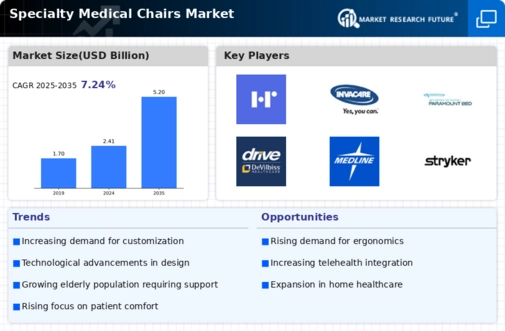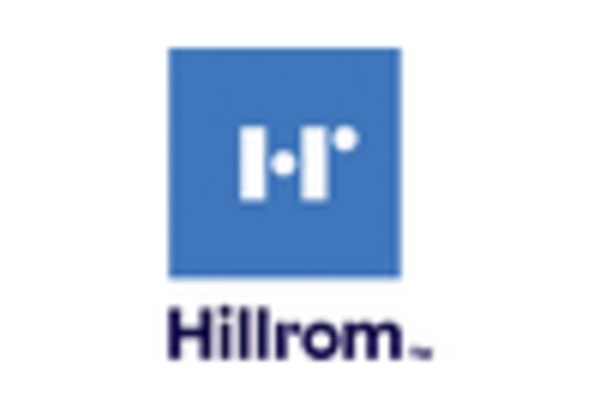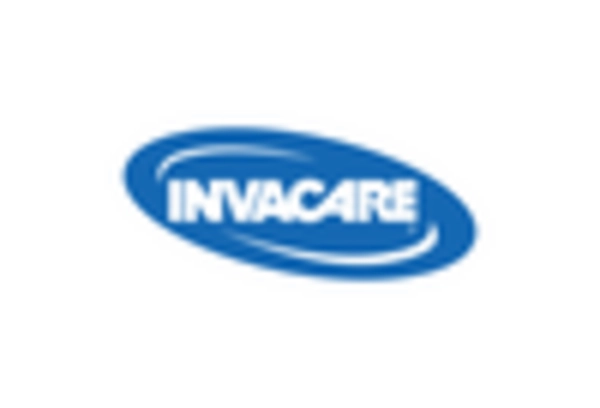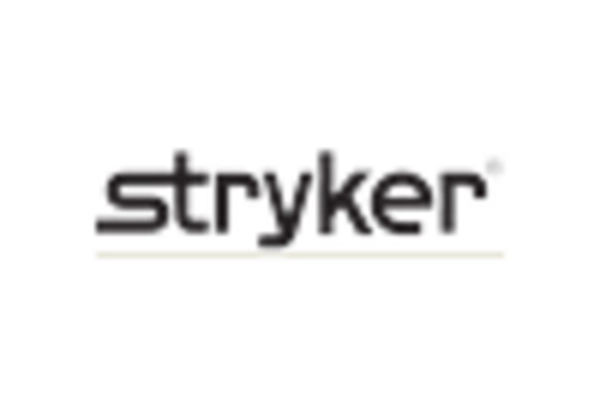Aging Population
The Specialty Medical Chairs Market is significantly influenced by the aging population, which is projected to increase in the coming years. As individuals age, they often require specialized medical care, leading to a higher demand for specialty medical chairs designed for various healthcare settings. According to demographic data, the proportion of individuals aged 65 and older is expected to rise, creating a substantial market for products that cater to their unique needs. Specialty medical chairs that provide enhanced support and comfort are essential in settings such as hospitals, rehabilitation centers, and nursing homes. This demographic shift indicates a growing market potential for the Specialty Medical Chairs Market, as healthcare providers adapt to accommodate an older patient population.
Technological Innovations
The Specialty Medical Chairs Market is experiencing a surge in technological innovations that enhance patient comfort and healthcare efficiency. Advanced features such as automated adjustments, integrated monitoring systems, and smart connectivity are becoming increasingly prevalent. These innovations not only improve the user experience but also streamline healthcare processes. For instance, the integration of telehealth capabilities within specialty chairs allows for remote patient monitoring, which is particularly beneficial in outpatient settings. As healthcare providers seek to improve patient outcomes and operational efficiency, the demand for technologically advanced specialty medical chairs is likely to rise. This trend suggests a robust growth trajectory for the Specialty Medical Chairs Market, as facilities invest in modern equipment to meet evolving patient needs.
Regulatory Support and Standards
The Specialty Medical Chairs Market is positively impacted by regulatory support and the establishment of standards that ensure product safety and efficacy. Regulatory bodies are increasingly recognizing the importance of specialty medical chairs in healthcare settings, leading to the development of guidelines that manufacturers must adhere to. Compliance with these regulations not only enhances product credibility but also fosters innovation within the industry. As manufacturers strive to meet these standards, they are likely to invest in research and development to create safer and more effective specialty medical chairs. This regulatory environment is expected to drive growth in the Specialty Medical Chairs Market, as healthcare providers seek compliant products that enhance patient care.
Increased Focus on Patient-Centric Care
The Specialty Medical Chairs Market is witnessing a paradigm shift towards patient-centric care, which emphasizes the importance of patient comfort and satisfaction in healthcare delivery. This trend is driving the demand for specialty medical chairs that are designed with the patient's needs in mind. Healthcare facilities are increasingly recognizing that comfortable and supportive seating can lead to improved patient outcomes and satisfaction scores. As a result, there is a growing emphasis on ergonomic designs and customizable features in specialty medical chairs. Market data indicates that facilities investing in patient-centric solutions are likely to see a return on investment through enhanced patient loyalty and reduced turnover rates. This focus on patient-centric care is expected to propel the Specialty Medical Chairs Market forward.
Rising Demand for Home Healthcare Solutions
The Specialty Medical Chairs Market is also being shaped by the rising demand for home healthcare solutions. As more patients prefer receiving care in the comfort of their homes, there is an increasing need for specialty medical chairs that are suitable for home use. These chairs must combine functionality with aesthetics to fit into residential environments while still providing the necessary support and features for medical care. The trend towards home healthcare is supported by demographic shifts and advancements in telemedicine, which facilitate remote monitoring and consultations. Consequently, manufacturers are likely to focus on developing specialty medical chairs that cater to this growing segment, thereby expanding the Specialty Medical Chairs Market.


















Leave a Comment